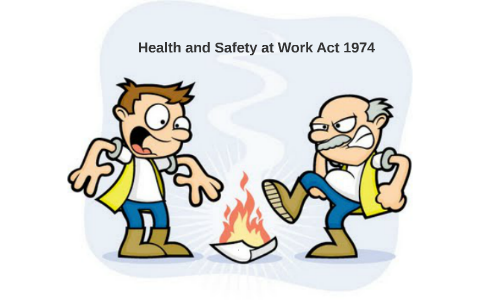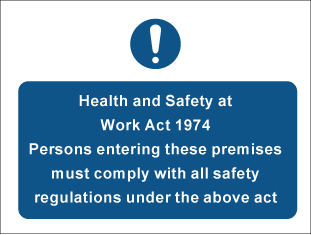The Health and Safety at Work Act 1974 is a piece of legislation in the United Kingdom that sets out the general duties of employers, employees, and self-employed individuals to ensure the health, safety, and welfare of people at work. It applies to all workplaces and work activities in the UK, including those in the public, private, and voluntary sectors.
The Health and Safety at Work Act 1974 places a number of legal duties on employers to protect the health and safety of their employees. This includes providing a safe working environment, ensuring that equipment and machinery are safe to use, and providing appropriate training and supervision. Employers must also assess the risks to the health and safety of their employees and take appropriate measures to control those risks.
Employees also have legal duties under the Health and Safety at Work Act 1974. They are required to take reasonable care of their own health and safety, as well as that of others who may be affected by their actions. Employees must also cooperate with their employer in relation to health and safety matters and follow any reasonable instructions or training provided by the employer.
Self-employed individuals also have legal duties under the Health and Safety at Work Act 1974. They must take reasonable care of their own health and safety and that of others who may be affected by their work activities. They must also ensure that any equipment or machinery they use is safe and properly maintained.
The Health and Safety at Work Act 1974 also establishes the Health and Safety Executive (HSE) as the body responsible for enforcing health and safety legislation in the UK. The HSE has the power to inspect workplaces and take enforcement action if necessary. It can also provide guidance and support to employers and employees on how to comply with the Act.
Overall, the Health and Safety at Work Act 1974 is an important piece of legislation that helps to protect the health and safety of people at work in the UK. By ensuring that employers, employees, and self-employed individuals have clear legal duties to safeguard the health and safety of themselves and others, the Act helps to create safer and healthier workplaces.
Employees Responsibilities For Health And Safety At Work Act 1974

What is the aim of the Health and Safety at Work Act? The Health and Safety at Work Act 1974 HASAWA is a piece of legislation introduced to apply some broad duties and best practices for employers in regards to the health and safety of their workforce. Display Screen Equipment Regulations DSE 1992 amended 2002 These regulations cover those who use DSE at work for more than one hour at a time. These all set out in more detail the specific responsibilities pertaining to employers in different areas concerning health and safety, for example, working with hazardous chemicals, or working with display screens. Physician Thomas Percival studies this and sends his recommendations to parliament. This also extends to other people visiting the workplace premises such as temporary workers, casual workers, self-employed workers, clients, visitors and the general public.
Get Health and Safety at Work Act 1974

This sets the backdrop to the eventual Health and Safety at Work Act 1974. But moving on to the present day, surely serious health and safety issues are no longer an issue? The Health and Safety at Work etc Act is a pivotal piece of legislation, and try as politicians have to pull it apart, it has truly stood the test of time. You are now a female worker liberated by the drive for equality and emboldened by trade union membership. Game features: ★ 10 games modes: 3 x Time, Steps, 2xLong, 2xColors and 5xArcade ★ Varied gameplay: colored steps, left and right moving dark tiles, auto scrolling mode. Who does the Health and Safety at Work Act 1974 Apply to? You only need to take a quick look at the statistics on health and safety in the workplace since 1974 to see the positive impact the HSW has had on safety at work. These regulations can be all-encompassing or in some cases apply to certain industries and circumstances. This resulted in a simpler yet more comprehensive legislation.
Health and Safety at Work Act 1974 explained

What do employers need to do to abide by it? Time-and-motion studies and target-driven performance indicators are still stifling employee health, safety and wellbeing. It is consequently a monotonous and inhumane daily existence, which begins and ends just beyond the factory wall in a back-to-back terrace house without a garden, built cheaply and unsafely. Provisions al need to made to make sure that a safe working environment is provided with suitable provision over the relevant information. Without such advancements in health and safety, we would not have the safe working environments that have paved the way for progress in technology, science and innovation. Employees must also be properly trained on how to use and properly wear the PPE provided.
Understanding the Health and Safety at Work Act (1974)

The HSE is a national, independent watchdog for all issues surrounding work-related health and safety, with the aim to prevent injury, illness and death. We begin to see an increasingly sophisticated division of labour. I am hard pressed to think of any other act that has been as effective as ours. What are the other regulations that come under the Act? Outside of work, Richard enjoys travelling with his family, running and competing in triathlons. Without a properly documented record of incidents, it is impossible to know with any accuracy about events in the past.
Health and Safety at Work Act 1974 Explained

But importantly they eventually raised the question of why? Why would anyone adopt a job role which might do them harm? Employees responsibilities for health and safety at work act 1974 It shall be the duty of every employee while at work — a to take reasonable care for the health and safety of himself and of other persons who may be affected by his acts or omissions at work; and b as regards any duty or requirement imposed on his employer or any other person by or under any of the relevant statutory provisions, to co-operate with him so far as is necessary to enable that duty or requirement to be performed or complied with. You also get a Target Element of the Day! Update: Has Brexit Impacted the Health and Safety at Work Act? He finally suffers a nervous breakdown and runs amok, throwing the factory into chaos. The What are the employer responsibilities for The Health and Safety at Work Act? But this success story, one of triumph of morality over hard-nosed profiteering, cannot be told without mention of previous generations and the many millions of people whose experiences brought it about. And why are thousands in the UK still dying from occupational health exposures? This is known as unconscious bias. Further details on hse for young workers can be found here. What happens if I have an accident at work? What is the Health and Safety at Work Act? The Health and Safety at Work Act outlines the legal duties that employers have to protect the health, safety and welfare at work of all of their employees.
The Health and Safety at Work Act 1974

Reassuringly, the Act has successfully minimised work-related illness and death through the introduction and implementation of health and safety regulations. Richard Bedworth Sales Director, StaySafe Richard is a lone worker safety expert. This system has protected and nurtured those innovators who have created a world of work with limitless opportunities. Do you ever get aches, pains, eye strain or headaches after work? Are you protecting your lone workers? The factory acts were a series of acts passed by parliament to limit the number of hours worked by women and children, first in the textile industry, then later in all industries. As mentioned various statutory instruments and amendments have been brought into the overarching Health and Safety at Work Act in order to keep people safe when they are at work. HASAWA also provides all employers with the same general duty to protect the health and safety of non-employees in the work area, including the general public. Jane White is research and information services manager at IOSH Think about how much workplaces have changed, even in just the last 30 years.







